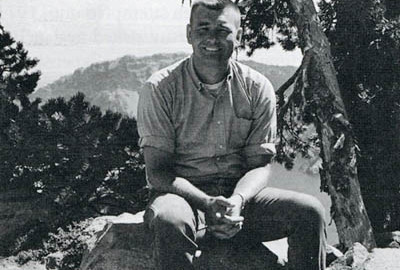Who was the assistant that the park provided?
There were several. I’ll get to that in a minute. I realized I needed some way to take samples from depth because I wanted to describe the phytoplankton throughout the water column. I had VanDorn bottles and I borrowed quite a bit of equipment from the Corps. In those days I had established a laboratory at Lost Creek Dam down on the Rogue. That lab had quite a bit of equipment. I bought a photometer and already had a transmissometer, and a fluorometer, as well as a lot of VanDorn bottles, and all kinds of equipment. I would take that equipment up to Crater. I borrowed it and took it up to Crater, but didn’t have a boat except for the rubber raft. One thing I needed was some way to sample from a rubber raft and I couldn’t do it with a winch. At the Lost Creek lab I had two of these heavy cast iron winches. They were like miniature cranes, but were heavy and would have sunk the raft. My dad lives in Corvallis and he’s real handy. He had a shop, and I expressed to him my need for a winch, but something that would work using a rubber raft. He came up with a wooden winch. It was actually a big spool. It had a handle on it and a guide. The Corps provided me with some funds and I bought 2,000 feet of rope. I put it on this spool he built and that’s what I used. As long as I positioned this thing right in center of the boat it was stable. You couldn’t crank the stuff out of the water, you had to hand haul the samples. For some of my samples I was going down as deep as 1500 feet, and I would string maybe 10 bottles out. Every 200 feet I would place a VanDorn bottle and I had them all set up to trigger with messengers attached to each one. When the upper one triggered, it dropped its messenger, which triggered the next one down, and so on until we closed all the bottles. In order to get a complete sample through the water column it would take maybe two hours to do all that, and then retrieve all the rope. I had to pull the rope into the boat and then wind up the excess, then continue to hand haul rope up and wind up the excess rope and so forth, until we brought the whole batch back. The first summer I collected a couple hundred samples, I suppose. In addition to that, I was also doing some other things: some basic limnology, looking at thermal profiles, measuring light penetration with the Secchi disk. I deployed the photometer so I was getting a handle on the spectral distribution of light in the water column and so on. I don’t know how many trips [to Crater Lake] I made that summer, probably seven or so. I did it on my own time. I’d take my vacation and go there.
Were they long weekends?
It was usually during the week. I would take vacation time and just do that, or sometimes I would do it in conjunction with my work at Lost Creek. I would take the government car and go to Crater with my supervisor’s permission. My supervisor was able to justify that because the Rogue River’s relationship to Crater Lake. Some of the water that seeps out of Crater may be feeding the Rogue system, who knows.


